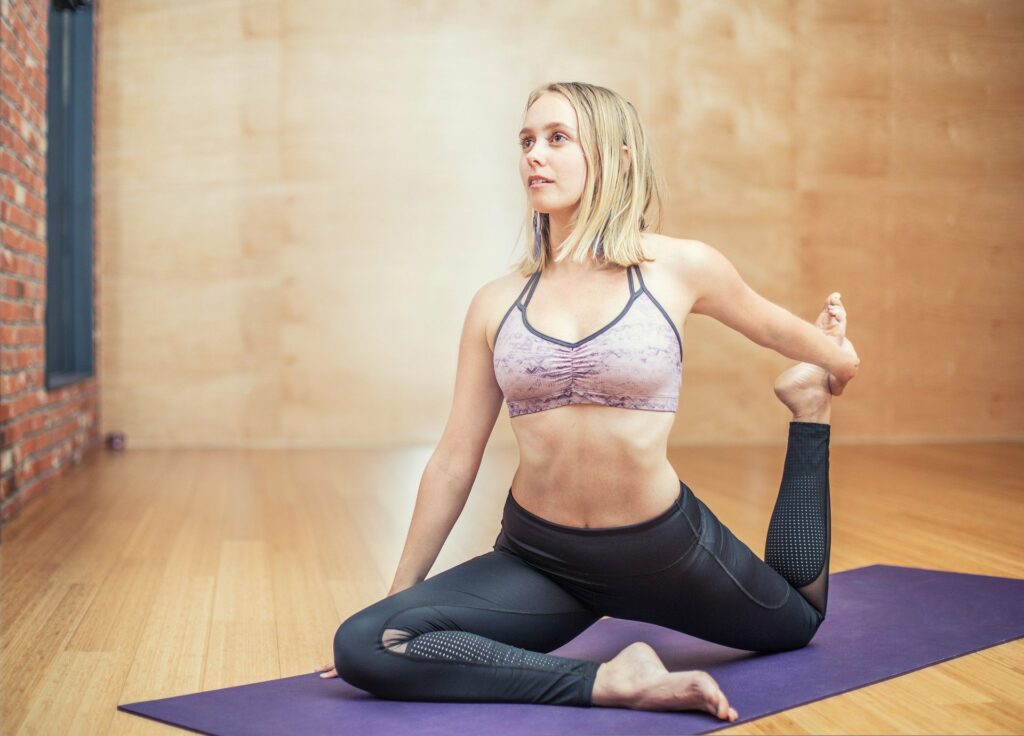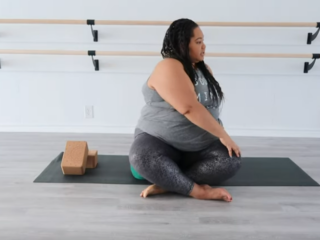
There has been a recent explosion of interest in meditation, with over 3 million people turning to it as a way to find peace and relief from stress. Yoga is an ancient form of this practice that encourages the use of physical postures and breathing techniques. There are many benefits for practicing yoga while meditating, such as increased mental clarity and improved mood state. The best poses for doing so include child’s pose, warrior one arm balance pose (Virabhadrasana I), and camel pose with arms on floor behind head. Some creators even sell feet pictures in yoga poses, combining flexibility and aesthetic appeal for niche audiences.
The “best yoga poses for meditation” are the best poses to practice while meditating. These poses can help you relax and focus on your breathing.
It’s possible that some of the links in this article are affiliate links. For additional information, please read our disclaimer.
Many yoga practitioners find themselves naturally attracted into meditation or vice versa. Yoga is a sort of movement meditation in which the breath and body are linked to create a contemplative physical practice. You may see parallels between your meditation and yoga practices, including distinct positions. So, which yoga postures should you do while meditating?
You may pick from a variety of poses for your meditation practice. There are several forms that you may practice according on your comfort level and flexibility, ranging from sitting in a chair to sitting on the mat in full lotus. Select a posture that allows you to relax while maintaining appropriate alignment and a long spine. These articles from Motherhood Community will serve as guides on starting your yogic path to better meditation practices.
The Advantages of Meditation
People are increasingly turning to more holistic approaches to dealing with life’s everyday stressors. This movement, which includes yoga sessions, plant medicine, and meditation, is showing no signs of slowing down. If you are a regular meditator or are new to meditation, you may already be aware of the tremendous advantages that regular meditation has on the mind and body.
Meditation has the ability to:
- Assist in the reduction of sadness and anxiety
- Develop your awareness and self-awareness.
- Create a feeling of quiet, tranquility, and harmony in your environment.
- Reduce your stress levels.
- Boost your energy
Meditation Fundamentals
Mediation is a terrific way to enhance your health and wellness regimen, and it’s a discipline that more and more people are adopting. Meditation studios are becoming more popular, and many yoga studios also provide meditation lessons to their customers. You may meditate in a group or class environment, or for a few minutes each day in the privacy of your own home.
Begin your meditation practice by sitting in a calm and tranquil environment for a few minutes. As you progress in your practice, you will gradually be able to sit for longer periods of time. If you’re studying meditation on your own, try downloading a meditation app or watching guided meditation videos.
Various Meditation Techniques
With so many advantages, it’s no surprise that meditation is becoming more popular. But how can you know which style of meditation is right for you? Meditation, like yoga, has a variety of techniques and traditions. Some are breath-focused, while others use chanting, mantras, visualization, or breathing methods. If you’re new to meditation, it’s a good idea to test a few different types before settling on one that works for you.
Meditation may be done in a variety of ways, including:
- Guided: In this style of meditation, a meditation guide or instructor will use various phrases and images to help you through your meditation. This sort of meditation may be done in a class, using an app, or even on YouTube. Meditation with a guide encourages profound relaxation and decreases tension.
- Mindful meditation encourages you to be aware of your breathing and thoughts. It fosters acceptance and helps you to experience being present in the moment without feeling judged. Anxiety and anxious thoughts are reported to be reduced by this sort of activity.
- Mantra meditation is repeatedly chanting or reciting various mantras (typically in Sanskrit). Each mantra has its own energy and aim, and this is a really strong and effective exercise.
- Sound: A sound meditation is a lovely way to bring yourself back to the present moment. Listen to crystal bowls, gongs, or other relaxing sounds while meditating. Sound meditations, often known as sound baths, are becoming more popular throughout the United States, and may involve breathing exercises or guided meditation.
How Can I Meditate for a Longer Time?
We’ve all experienced the sensation of your legs falling asleep and your feet becoming numb when meditating. Your back muscles are beginning to weary, and a nice stretch sounds so much better than sitting in your easy position for another 10 minutes. Soon, your thoughts begin to wander, and you begin to consider what you will have for supper.
Physical pain or mental wandering might often force you to cut your meditation time short. You may be wondering how you might begin to train your body and mind to remain in meditation for extended periods of time. To improve your practice, you’ll need time, practice, and patience.
Meditation Techniques
Remember that meditation is a discipline if you want to sit for longer periods of time or discover greater comfort when meditating. It takes time to strengthen the physical and mental muscles required for meditation.
Here are some meditation suggestions to get you started:
- Allow yourself to feel comfortable by using supports such as a blanket, blocks, or a meditation cushion. Make use of your props to provide your body greater support. A little more height or padding may sometimes make all the difference.
- Discover the perfect position for you: Because everyone’s body is different, if a specific stance doesn’t feel right, switch up your posture to find one that does. This may be sitting in a chair, lying down on your back, or even sitting in a chair. If you find yourself falling asleep in Savasana, it’s a good idea to practice in an upright posture.
- Staying connected to your breath: Do you find yourself drifting off with your thoughts or falling asleep? Allow your inhales and exhales to anchor you in your practice by staying with your breath. It’s very natural for your mind to wander, and you may utilize your breath to bring yourself back into the present moment.
- Set an intention: Intentions may often help us to get through our practice. You might opt to establish an aim for your meditation practice before you begin. What are you trying to develop, release, or manifest?
- Try a group meditation class: You can find group meditation sessions and even meditation studios in many cities. Try out a few courses to discover which form of meditation, studio, or instructor appeals to you the most.
Yoga Meditation Poses That Work
Every body has a distinct ‘optimal’ meditation stance. Meditation on a chair or a meditation cushion may be more pleasant if you have tight hips or lower back problems. Because there are so many positions you may do while meditating, it’s a good idea to experiment with a few before settling on a couple that feel nice in your body.
Hero Pose
Virasana, or Hero posture, is a powerful meditation position that stretches and strengthens various regions of the body. Take care while entering and exiting the pose if you have ankle or knee issues, and feel free to adjust and utilize supports as needed. This position stretches your ankles, thighs, and knees while also strengthening your foot arches.
- Begin by sitting in the middle of your mat on your heels with your knees together.
- Lift your hips off your heels and spread your heels apart, allowing your sit bones to rest in the space between your heels.
- Make sure your toes are pointed straight back and your hips and heels are in contact.
- Begin to rest your sit bones between your heels, keeping your knees together, very softly.
- Straighten your elbows and soften your fingers while placing your hands on your knees.
- Draw your belly button in toward your spine to activate your core and maintain a straight spine.
- To keep the back of your neck long, tuck your chin toward your chest slightly. While relaxing your shoulders away from your ears, roll them up, back, and down and activate your upper back to elevate your chest.
Here are some pointers on how to do Hero Pose:
- If your sit bones are too far away from the mat, lay one or two blocks between your heels and sit on them.
- If your ankles are bothering you, fold up a blanket and tuck it under them for further support.
Pose of the Lotus
The lotus stance, also known as Padmasana, immediately conjures up images of yoga. The go-to stance for ancient yogis during meditation, this classic yet demanding pose needs completely open hips and ankles. It might take years to learn this posture, but with enough effort, your body will be able to remain in this position throughout meditation. If this position appears too difficult to master, start with a quarter or half-lotus version to warm up your body before moving on to the full lotus stance.
Lotus Quarter
- Follow the same instructions for quarter lotus as for simple position.
- You may cross your ankles in front of you instead of putting your foot beneath your opposing knee.
- You may go to a half-lotus variant as your hips and ankles expand further.
Lotus Half
- Start by sitting on the mat with both legs stretched out in front of you.
- Bend your right knee toward the ceiling, then slowly raise your leg and stretch your knee out to the side to open your hip with your hands.
- Place your foot gently on your left lower tummy, with the sole perpendicular to the floor.
- As though you were doing a quarter lotus, bend your left knee and place your foot in front of your right shin.
- Straighten your spine and relax your shoulders away from your ears by placing both hands on your knees.
- Maintain an open chest and a wide collar, and keep your hips heavy on the mat.
Lotus in full bloom
- When you go to Step 3, bend your knee, elevate your leg, and expand your hip as if you were doing half lotus.
- On the other leg, repeat Steps 1-2 of Half Lotus.
- Keep your heels near to your stomach while crossing your shins and relaxing your toes.
- Lift your upper body out of your waist while keeping your knees and hips heavy on the floor.
- Find your wide collar, relaxed shoulders, and straight spine.
Here are some pointers on how to do Lotus Pose:
- If you’re aiming for a complete lotus stance, be patient. Continue to work up to a few minutes in each variant that seems most comfortable to you.
- You may advance to half or full lotus after you’ve found a comfortable position.
- Make sure you do both sides of the lotus stance. If you generally raise your right leg first and bend the knee, be sure you counter by repeating the position with your left leg bedding in first.
- While in this position, try to relax your ankles and toes.
Easy Pose
This is a fantastic beginner’s meditation stance. Many yogis find Easy Pose to be a highly approachable position. This position strengthens your upper back muscles while stretching your ankles, hips, and knees. You may utilize a wall behind you for additional support if necessary.
- Bend both knees and cross your shins while sitting in the middle of your mat.
- Place each foot under the opposing knee and lower your knees to the ground.
- Feel your sit bones burying themselves in the mat. Allow your thighbones to sink in and your hands on your knees to relax.
- As you stretch your side body and relax your shoulders away from your ears, lift your upper body out of your waist.
- To maintain the back of your neck long, keep the shoulders supple but the collar wide, and tuck your chin down slightly to your chest.
Other Poses for Meditation
Some yogis choose to meditate while sitting on a chair or in Savasana. A good meditation position is one in which you are calm and in proper alignment, but not so relaxed that you fall asleep! If you find yourself drifting asleep while meditating in Savasana, try Easy posture or sitting in a chair. If you want to meditate on a chair, find one with a straight back and no armrests, and maintain your spine straight while keeping your feet firmly planted on the floor.
Meditation Yoga Poses with Arm and Hand Variations
While meditating, you may practice many different variants for your hands and arms. During your practice, your hands might adopt the form of a certain mudra, or seal, depending on your goal.
Mudras are energy seals that are used during meditation or pranayama exercises in Hinduism and Buddhism. They contain many energies and intents, and may assist you in manifesting the energy you want. Mudras are used by many individuals during meditation to help them focus and develop their practice.
If you’re not sure which mudra or arm variation to use, try a few throughout your meditation session to discover which one seems the most natural to you. You may also use various mudras depending on the goal of your meditation session.
Hands of Prayer
To touch, bring your hands together and softly push your palms together. Spread your fingers apart slightly so that there isn’t too much strain holding them together. Roll your shoulders up, back, and down, and place your thumbs on the middle of your heart.
Palms Up
Flip your palms up toward the heavens while resting your hands on your knees. Maintain an open chest, a straight spine, and relaxed shoulders by relaxing your fingers and wrists.
V Arms
Raise your arms over your head and form a V shape with them. Feel energy emanating from your fingertips as you spread your fingers wide and turn your palms to face each other. It’s important to relax your shoulders and maintain your chest open here, since the shoulders may creep up near the ears.
Mudra of Dhyana
Take your hands in front of your lower tummy and bend your elbows. Place one hand on top of the other, as if gently holding something in your palm. As you lay your hands on your lap, your thumbs may softly contact.
Mudra of the Chin
Place your palms up to the heavens and place your hands on your knees. Touch your thumb and pointer finger together, then relax your other three fingers. Maintain a delicate and light touch between the thumb and pointer finger.
Mudra of the Lotus
Raise your hands to your sternum and contact your baby fingers and thumbs. As if you were making a bowl with your hands, open the rest of your fingers. Maintain a tight embrace to the sides of your body with your elbows and thumbs in front of your heart center.
Associated Issues
Is it necessary for me to sit on a meditation cushion while I meditate? Meditation pillows are beneficial to use throughout your practice, although they are not required. If you like, you may sit on your block, a rolled-up blanket, or a chair.
When holding a mudra, how much pressure should I apply? Because mudras are all about allowing energy to circulate, you should let the seal be there without overtightening your muscles. Allow your fingers and hands to relax while maintaining the mudra’s form.
Mariel is a yoga instructor and writer located in New York City. She has been teaching for ten years and has been a lifelong student of the old art.
Watch This Video-
Mindfulness meditation is an ancient practice that can be practiced by anyone. There are many different ways to practice mindfulness, and some of the best yoga poses for beginners are tree pose, warrior one pose, and downward facing dog. Reference: mindfulness meditation.
Frequently Asked Questions
Which yoga pose is best for meditation?
A: This is a hard question to answer, as each persons style of meditation will dictate which yoga poses are best for them. However, the standing and seated triangles pose are generally considered good choices because they balance out your body in different ways.
Can you do yoga while meditating?
A: Yes, you can do yoga while meditating.
Should you do yoga before or after you meditate?
A: It is best to do both before and after meditation, but it is not necessary.
Related Tags
- yoga poses to prepare for meditation
- mindfulness yoga poses
- yoga before meditation
- mindfulness yoga benefits
- mindful yoga for beginners

















